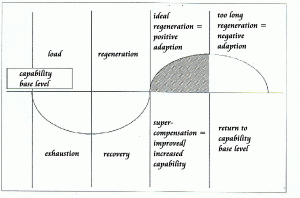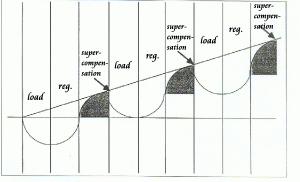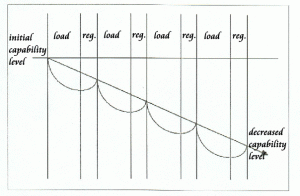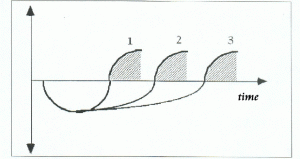Correct Weight Training Frequency
Weight Training Frequency is the rhythm in which you are performing your weightlifting, that is the time between two regularly executed weight trainings.
Weight training load is the stress put on distinct parts of the musculo-skeletal system of the athlete during the work out, or the effects of the training stimulus and the adaptation processes initiated through it.
The weight training load can only be optimally dosed if the processes in the organism are known and understood.
Adaptation
Any living being has the ability to adapt to different environmental conditions (stimuli). Physical charges stimulate the involved organs (i.e. muscles) for adaptation to be able to master the next load better. Adaptation in biology signifies an organic and functional adjustment of the organism.
Regular weight training leads in principle to perpetual adaptations and thereby to an increase of strength. But to reach an optimum increase of strength an optimum weight training also has to be performed.
Training stimuli – above threshold training stimulus
There are different training stimuli, classified by different load dosage characteristics:
- Missing training stimuli: the function of the musculature is stopped (e.g., by a cast), so that it can get to atrophy (decline) and even complete functional incompetency.
- Subliminal training stimuli: the movement stimuli are so low that the functions of the organs get worse. As with the missing training stimuli an atrophy occurs down to the just necessary requirement-level.
- Normal training stimuli: the organ functions will be obtained (maintaining strength), but no adaptation process is initiated . The threshold to maintain strength lies at loads of about 30% of the maximum capability.
- Above threshold training stimuli: Just these will initiate adaptation processes, that means improvement of the single metabolism functions. To achieve an improvement, the athlete has to train above the threshold necessary to maintain strength.. So the training has to be done with loads between 50% and 90% of the maximum capability. But you have to consider that just due to the phenomenon of the adaptation which goes along with the progressive weight training, the in the beginning strong training stimuli will drop over time to below threshold stimuli. This means for weight training , that with increasing adaptation all training parameters must be increased, i.e. the stimulus density, intensity, duration, frequency.
- Too strong training stimuli: permanently too strong training stimuli lead to a strong decrease of the bodily functions, to lowered capabilities, to overtraining.
Supercompensation
Supercompensation signifies an increase of the capability over the base level, an over adjustment.
To get to that, at first a training stimulus above threshold is necessary.
Through the training it comes to exhaustion, to a lowered capability. First the organism needs time to recover the capability, and then to carry out the adaptation processes which were initiated by the weight training stimuli above threshold. In the recreational time the body regenerates not only up to the base level, but beyond it. If the rest is too long until to the next weight training stimulus, it comes to a gradual return to the base level, and maybe even below.

Supercompensation Cycle
If the next workout occurs when the point of the highest adaptation is reached, then it is the optimum temporal sequence for a continuous improvement of the capability:

Supercompensation Ideal Curve
If the next work out occurs too early, i.e. if the body has not recovered completely yet, it leads to a decrease of the capability and possibly to overtraining (beside causes outside the weight training itself, also causes for overtrainings can be a to quick increase of the training quantity, too short rests, too high training intensity.):

Supercompensation Overtraining
Regeneration / recovery
Fatigue/exhaustion
The recovery depends on the degree of the training-conditioned exhaustion. This exhaustion has it’s cause in different biochemical processes which take place in the body during the weight training:
- Changes in cell structures
- Changes of the enzyme content
- Consumption of energy rich compounds
- Aggregation of intermediate and end products of the metabolism
These biochemical processes lead to a disturbance of the motion sequence up to inability to carry out movements and to coordination weak points in neuromuscular systems as a result of disorders of the central nerves system.
Restoration
As soon as the body’s dynamic balance gets destabilized (also disturbance of the homeostasis called) by training the restoration begins. This happens in several phases:
- Phase of the load: the stimuli for adaptation processes are set
- Phase of the general construction: the re-replenishment period
- Phase of the excessive restoration above the previous base level
- Phase of the regulation into the state of equilibrium
With the restoration a normalization of the internal state of the whole organism occurs by:
- Replenishment of spent energy materials, construction materials and vital materials
- Regulation of the enzyme and hormone household
- Restoration more optimally of neuromuscular excitability and therefore optimum capability of the central nervous system.
These restoration processes take differently long, depending on how well the respective metabolism / the supply with nutrient and construction materials is:
- Briefly persistent restoration processes of seconds to minutes: e.g., ATP-creatin-phosphate-re-synthesis; muscle system. The quick regeneration and quick adaptation are possible by a very good supply with nutrient and construction materials.
- Restoration processes of intermediate duration of approx. 10 minutes up to a few hours: e.g., glykogen-construction-processes; tendons and sinews. The moderate regeneration and moderate adaptation are explained by the fact that the supply by diffusion is a little bit slow.
- Long restoration processes of hours to days: e.g., enzyme-re-synthesis; joints and cartilages. The slow regeneration and bad adaptation are explained by the fact that the supply takes place only with adequate movement.

Supercompensation Regeneration Curves
It is clear to see that at first the musculature recovers, while other structures of the movement apparatus have not recovered yet. This explains strains and injuries if the athlete weight trains too early again.
Because there is no possibility to check accurately how far the restoration has progressed, it is difficult to find out the optimum regeneration time. It depends on individual conditions (age, injury, health, nutrition, …) as well as on the intensity of the weight training and will vary.
